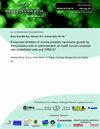Running intralimb coordination patterns after a foot core exercise program in recreational runners
IF 1.9
4区 医学
Q2 BIOLOGY
Brazilian Journal of Medical and Biological Research
Pub Date : 2024-01-22
DOI:10.1590/1414-431X2023e13124
引用次数: 0
Abstract
This study investigated the effects of a foot core intervention on the coordination of foot joints in recreational runners. This was a secondary analysis from a randomized controlled trial conducted with 87 recreational runners allocated to the control group (CG), which followed a placebo lower limb stretching protocol, or the intervention group (IG), which underwent an 8-week (3 times/week) foot core training. The participants ran on a force-instrumented treadmill at a self-selected speed (9.5-10.5 km/h) while the foot segment motion was captured. The vector coding technique was used to assess inter-joint coordination for four selected coupled segment and joint angles. The coordination patterns of the calcaneus and midfoot (CalMid) and midfoot and metatarsus (MidMet) joint pairs were affected. In the frontal plane, IG showed an in-phase with proximal dominancy coordination at heel strike, with a decrease in its frequency after the training (P=0.018), suggesting a longer foot supination. Additionally, IG showed an anti-phase with distal dominancy pattern at early stance compared to CG due to a smaller but earlier inversion of the CalMid-MidMet pair (P=0.020). The intervention also had an effect on the transverse plane of the CalMid-MidMet pair, with IG showing a significantly greater frequency of anti-phase coordination with proximal dominancy during propulsion than CG (P=0.013), probably due to a reduction in the CalMid abduction. Overall, the results suggested that the foot core intervention reduces the occurrence of running-related injuries by increasing the resistance to calcaneus pronation and building a more rigid and efficient lever during push-off.休闲跑步者接受足部核心锻炼后的肢体内部协调模式
本研究调查了足部核心干预对休闲跑步者足部关节协调性的影响。这是一项随机对照试验的二次分析,87 名休闲跑步者被分配到对照组(CG)和干预组(IG),对照组采用安慰剂下肢伸展方案,干预组则接受为期 8 周(每周 3 次)的足部核心训练。参与者在测力跑步机上以自选速度(9.5-10.5 公里/小时)跑步,同时捕捉足部运动。矢量编码技术用于评估四个选定耦合节段和关节角度的关节间协调性。小腿和中足(CalMid)以及中足和跖骨(MidMet)关节对的协调模式受到了影响。在前方平面,IG 在脚跟着地时显示出与近端优势协调的同相位,训练后其频率降低(P=0.018),这表明脚上移的时间更长。此外,与 CG 相比,IG 在早期站立时表现出与远端优势模式反相,这是因为 CalMid-MidMet 对的反转较小但较早(P=0.020)。干预还对CalMid-MidMet对的横向平面产生了影响,在推进过程中,IG与CG相比显示出明显更高的反相位协调与近端优势(P=0.013),这可能是由于CalMid外展的减少。总之,研究结果表明,足部核心干预通过增加对小腿骨前伸的阻力以及在推举过程中建立更坚固、更高效的杠杆,减少了跑步相关损伤的发生。
本文章由计算机程序翻译,如有差异,请以英文原文为准。
求助全文
约1分钟内获得全文
求助全文
来源期刊
CiteScore
4.00
自引率
0.00%
发文量
129
审稿时长
2 months
期刊介绍:
The Brazilian Journal of Medical and Biological Research, founded by Michel Jamra, is edited and published monthly by the Associação Brasileira de Divulgação Científica (ABDC), a federation of Brazilian scientific societies:
- Sociedade Brasileira de Biofísica (SBBf)
- Sociedade Brasileira de Farmacologia e Terapêutica Experimental (SBFTE)
- Sociedade Brasileira de Fisiologia (SBFis)
- Sociedade Brasileira de Imunologia (SBI)
- Sociedade Brasileira de Investigação Clínica (SBIC)
- Sociedade Brasileira de Neurociências e Comportamento (SBNeC).

 求助内容:
求助内容: 应助结果提醒方式:
应助结果提醒方式:


